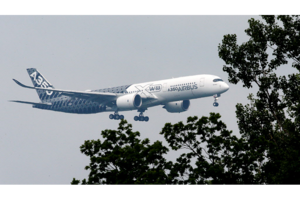Why Airbus wants slime from green algae to fuel its planes
Algae grows faster and produces higher energy yields than other plants, but is much more expensive to turn into fuel than traditional petroleum byproducts.

An Airbus A350, seen here in May 2016, could someday be powered by algae-derived biofuel. A research project at an Airbus site in Germany is working to turn algae into biofuel for jets.
Fabrizio Bensch/Reuters
Your next flight could be powered by slime. As long as you don't fly for a few decades.
Airbus researchers are growing algae for biofuel in tanks near Munich, just one in a growing number of efforts to make flying more environmentally sustainable.
But algae won't fuel the commercial flights any time soon, says researcher Thomas Brueck, an associate professor of industrial biocatalysis at Munich Technical University, who predicts algal biofuel could supply up to 5 percent of jet fuel needs by 2050.
“To substitute 100 percent of the kerosene use today, we will not do it with algae alone,” Professor Brueck told Reuters. “We need a combination of different technologies to actually enable that substitution.”
Because the aviation and shipping industries are on pace to contribute nearly half of all carbon dioxide emissions by 2050, algal fuel might not be the sole answer to curbing the airline industry’s fossil fuel addiction.
But these and other efforts to develop commercially practical biofuel point to an industry committed to discovering a sustainable solution.
Although emissions from air travel contribute only two percent of global greenhouse gas emissions, they contribute about 12 percent of carbon dioxide (CO2) emissions from all transportation sources, according to the International Civil Aviation Organization, a United Nations agency, as reported by The Christian Science Monitor’s Olivia Lowenberg.
The growing popularity of air travel is expected to drive those numbers up. Aviation and shipping are expected to contribute 40 percent of all carbon dioxide emissions by 2050, according to a study by University College London’s Energy Institute. Scientists around the world are trying to make sure that doesn’t happen.
Airbus isn't the only company exploring biofuels. In 2008, Air New Zealand conducted a test flight of a Boeing 747-400 flown on a 50-50 mixture of biofuel made from jatropha oil, derived from the plant with the same name, and traditional jet fuel, according to The New York Times.
A few months later, Japan Air conducted test flights of planes also powered by a half-and-half mixture of biofuel and kerosene jet fuel. The biofuel was made up of 84 percent camelina oil, 16 percent jatropha oil and less than 1 percent algal pond scum, the Monitor reported at the time.
Solazyme, a California biotech firm, already produces algal jet fuel, in addition to algal-based diesel fuels for cars, trucks, and navy vessels, according to Popular Science.
Algal fuel offers advantages over biofuels like ethanol. Algae can grow 12 times faster than plants grown in soil, and it produces an oil yield about 30 times that of rapeseed. But turning algae into biofuel is expensive and technically challenging.
Growing algae requires much more carbon dioxide than other plants, according to Popular Science, which recommended either growing it near high-carbon sources such as coal-fired power plants, or genetically modifying it to need less CO2.
After it has grown, converting algae to biofuel requires removing plant cellulose from the biomass, an expensive process, reported the Monitor’s Cristina Maza. To do this, plants must sit in hot acid or under steam pressure, which requires an expensive grade of stainless steel.
Researchers are working to genetically modify plants to make it easier and cheaper to remove plant cellulose, writes Ms. Maza, but this might reduce their yield and make them more susceptible to pathogens or rust.
At the same time, oil prices are low, reducing incentives to develop biofuel, which can cost up to three times more than traditional fuels, reported the Monitor’s Ms. Lowenberg.
Regardless, Airbus has high hopes for its project.
“We are sure that over time we will make it possible to offer kerosene made of algae for a competitive price,” said a spokesman.
Material from Reuters was used in this report.

